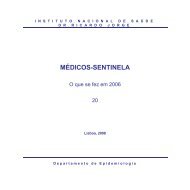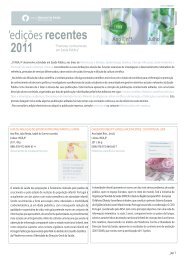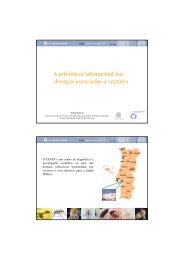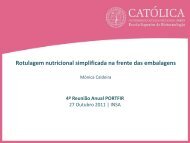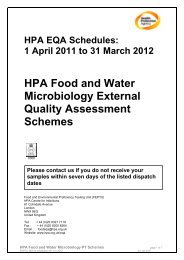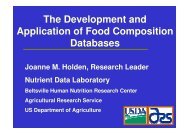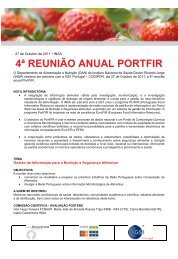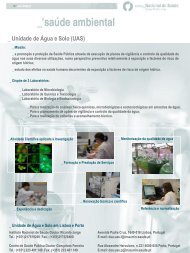European Society of Mycobacteriology - Instituto Nacional de Saúde ...
European Society of Mycobacteriology - Instituto Nacional de Saúde ...
European Society of Mycobacteriology - Instituto Nacional de Saúde ...
You also want an ePaper? Increase the reach of your titles
YUMPU automatically turns print PDFs into web optimized ePapers that Google loves.
PP-109<br />
PREVALENCE OF EFFLUX-MEDIATED RIFAMPICIN RESISTANCE<br />
IN Mycobacterium tuberculosis CLINICAL ISOLATES<br />
Carrie K. W. Au-Yeang, T. K. Au, Edward W. C. Chan, Raphael C. Y. Chan<br />
Department <strong>of</strong> Microbiology, The Chinese University <strong>of</strong> Hong Kong, The Prince <strong>of</strong> Wales Hospital, Shatin, New Territories, Hong Kong<br />
Rifampicin is one major ingredient in the cocktail-regimen used in treatment <strong>of</strong> Mycobacterium tuberculosis (MTB) infection.<br />
Although mutations in the rpoB gene are consi<strong>de</strong>red the basis <strong>of</strong> rifampicin resistance, we noted that a significant<br />
proportion <strong>of</strong> local resistant cases could not be attributed to mutations. Alternative mechanisms such as drug efflux<br />
have been proposed. In or<strong>de</strong>r to evaluate the role <strong>of</strong> drug efflux mechanisms in mediating rifampicin resistance in MTB,<br />
we examined the prevalence <strong>of</strong> efflux activities in rifampicin resistant isolates using three efflux inhibitors: reserpine,<br />
carbonyl cyani<strong>de</strong> chlorophenylhydrazone and verapamil. Forty-two rifampicin resistant and nine drug susceptible MTB<br />
clinical isolates were studied. The minimum inhibitory concentration (MIC) values for rifampicin were <strong>de</strong>termined in the<br />
presence and absence <strong>of</strong> efflux inhibitors. The magnitu<strong>de</strong> <strong>of</strong> MIC reduction for each efflux inhibitor and the prevalence<br />
<strong>of</strong> efflux-mediated resistance were examined. We found that among the three efflux inhibitors tested, significant MIC<br />
reduction, ≥ 2-fold MIC <strong>de</strong>crease, was observed only for verapamil. 61% (31/51) <strong>of</strong> the test isolates had an MIC reduction<br />
between 2 to 8-fold in the presence <strong>of</strong> verapamil. This verapamil-sensitive efflux-mediated MIC reduction effect<br />
was much more apparent in rifampicin resistant isolates than the drug susceptible controls: 71% (30/42) versus 11%<br />
(1/9). Likewise, this phenomenon was more prevalent in isolates resistant to 3 - 5 anti-tuberculosis drugs than isolates<br />
resistant to 1 - 2 drugs: 77% (24/31) versus 55% (6/11). This data support the notion that drug efflux systems contribute<br />
significantly to rifampicin resistance in MTB clinical isolates and highlight the need for <strong>de</strong>termining the extent by which<br />
these systems contribute to resistance to other anti-tuberculosis drugs.<br />
This study is supported by a grant (08070292) from Research Fund for the Control <strong>of</strong> Infectious Diseases.<br />
<strong>European</strong> <strong>Society</strong> <strong>of</strong> <strong>Mycobacteriology</strong> | 30 th Annual Congress | July 2009 | Porto - Portugal<br />
181



